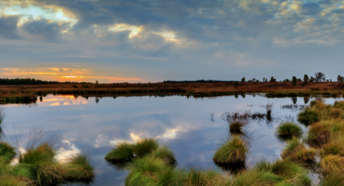Did you know… that the red in autumn leaves is actually there all year?
Autumn is synonymous with the changing colour palette of the leaves on our deciduous trees. From the bright and vivid greens we see the change to reds, ambers and yellows that everyone recognises as the end of the summer months. Most people will know that this change signals autumn, but what you might not know is that the reason the leaves actually become more red and yellow is down to disappearing chlorophyll.
That’s right. The colder temperatures and lower levels of light actually destroy the chlorophyll in the leaves and the chlorophyll is the pigment that makes leaves green. The reds, oranges and yellows we then see appearing have actually been there all along, just hidden by the green pigment for the spring and summer months. The chemical chlorophyll is an important part of photosynthesis but during the winter months, there is not enough light for this process to happen.
As they enter the early stages of dormancy, trees effectively shut down this food production system and shed their leaves to conserve water. When the days are short on sunlight it would be a drain for deciduous trees to keep their leaves, which need to be pumped with water. The tree simply takes a break from this task for a few months and in doing so, protects itself from freezing weather so it can reawaken in the spring.
As chlorophyll declines, other chemicals become more prominent in the leaves. The chemicals left in the leaves are types of flavonoids, carotenoids and anthocyanins and are responsible for the autumn colours that we know so well. These chemicals (carotenoids) are also the same ones that give carrots their orange tone!

So when does autumn officially begin?
Autumn (when defined by planet earth’s orbit around the sun) is said to begin on the equinox which falls this year on Friday 23rd September. Officially, the Met Office define autumn as the 1st of September to ensure that dates can be compared easily when it comes to meteorological data.
Some people will be welcoming the autumn vibes after the long hot summer we’ve had here in the UK and of course, it heralds the start of the new school term for many families. Autumn is definitely a period of change in many ways but it is still a great time to get out into the Surrey countryside. We encourage you to look out for these signs of autumn in your local area:
- Changing colours of the leaves on our deciduous trees from greens to red, orange and yellow.
- Migrating birds can be seen in huge flocks – such as swallows, who make a 6,000-mile journey to South Africa!
- Berries are an autumn favourite. Not just blackberries, but elderberries, sloes, rosehips and wild raspberries to name a few.
- Flowering ivy is one of the few plants that flower in the autumn months, providing vital nectar for our pollinators.
- Tree seeds are ripe in autumn and you’ll be used to the sight of plump acorns and ready to search for shiny brown conkers. Many trees rely on seeds falling to the ground, being carried by birds and animals or simply trust the wind to carry their seeds far and wide.
- Fungi is more suited to the damper weather of autumn and you’ll see many types thriving in the woodland near you.
As the nights start to draw in after the autumn equinox there’s less time to enjoy the countryside but plenty to see in the woodlands, heathlands and green spaces where you live. We’d love to see your pictures of beautiful Surrey in the Autumn, tag us in your images #surreyautumnvibes on Facebook, Instagram or Twitter.
If you are interested in helping us protect and celebrate the Surrey Countryside discover how you can get involved here.








